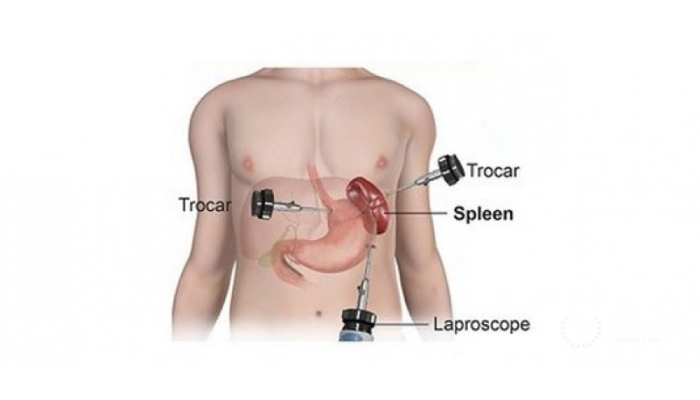Overview
Splenectomy is a surgical procedure to remove your spleen. The spleen is an organ that sits under your rib cage on the upper left side of your abdomen. It helps fight infection and filters unneeded material, such as old or damaged blood cells, from your blood.
The most common reason for splenectomy is to treat a ruptured spleen, which is often caused by an abdominal injury. Splenectomy may be used to treat other conditions, including an enlarged spleen that is causing discomfort (splenomegaly), some blood disorders, certain cancers, infection, and noncancerous cysts or tumors.

Risk Factors
Splenectomy is generally a safe procedure. But as with any surgery, splenectomy carries the potential risk of complications, including:
- Bleeding
- Blood clots
- Infection
- Injury to nearby organs, including your stomach, pancreas and colon
[/rt_list_style]
How Is a Splenectomy Performed?
You will be given general anesthesia a few minutes before surgery so you are asleep and do not feel pain while the surgeon is working on you. There are two ways to perform a splenectomy: laparoscopic surgery and open surgery. Laparoscopic splenectomy is done using an instrument called a laparoscope. This is a slender tool with a light and camera on the end. The surgeon makes three or four small cuts in the abdomen, and inserts the laparoscope through one of them. This allows the doctor to look into the abdominal area and locate the spleen. Different medical instruments are passed through the other openings. One of them is used to deliver carbon dioxide gas into the abdominal area, which pushes nearby organs out of the way and gives your surgeon more room to work. The surgeon disconnects the spleen from surrounding structures and the body’s blood supply, and then removes it through the largest surgical opening. The surgical openings are closed using stitches or sutures. Sometimes during laparoscopic splenectomy the doctor has to switch to the open procedure. This may happen if you have bleeding problems during the operation. Open splenectomy requires a larger surgical cut than the laparoscopic method. The surgeon makes an incision across the middle or left side of your abdomen underneath the rib cage. After locating the spleen, the surgeon disconnects it from the pancreas and the body’s blood supply, and then removes it. The surgical openings are closed using stitches or sutures.
How are Spleen Disorders Diagnosed?
Spleen disorders are diagnosed with:
- Blood tests, including complete blood count.
- Physical examination (an enlarged spleen may be felt by your healthcare provider).
- Imaging tests such as ultrasound or computerized tomography (CT) scans.
- Bone marrow tissue biopsy.
[/rt_list_style]
Book Your Appointment Today
Book your appointment with Dr. Ujwal Zambare he is having 12 years of experience in Gastro-intestinal surgery, oncology, minimally invasive surgery and Liver, Pancreas, Biliary tract surgery.
[lea_button_style title=”MAKE AN APPOINTMENT” align=”center” font_color=”#ffffff” use_theme_fonts=”yes” button_hover_style=”three” background_hover_color=”#ffffff” border_hover_color=”#ffffff” font_hover_color=”#000000″ link=”url:https%3A%2F%2Fdrujwalzambare.com%2Fcontact-us%2F” button_font_size=”13px” button_line_height=”23px” extra_class=”letter-spacing-1 font-weight-medium” button_design_css=”.vc_custom_1634216059928{margin-top: 0px !important;margin-bottom: 0px !important;border-top-width: 1px !important;border-right-width: 1px !important;border-bottom-width: 1px !important;border-left-width: 1px !important;padding-top: 12px !important;padding-right: 35px !important;padding-bottom: 12px !important;padding-left: 35px !important;background-color: rgba(255,255,255,0.01) !important;*background-color: rgb(255,255,255) !important;border-left-color: #ffffff !important;border-left-style: solid !important;border-right-color: #ffffff !important;border-right-style: solid !important;border-top-color: #ffffff !important;border-top-style: solid !important;border-bottom-color: #ffffff !important;border-bottom-style: solid !important;border-radius: 35px !important;}” animation=”none”]
Dr. Ujwal Zambare
MBBS, MS (General Surgery), DNB (Gastrointestinal Surgery)
Fellowship in Minimal Access Surgery
Copyright © 2021. Dr. Ujwal Zambare – Liver, Pancreas, Biliary Tract Surgery Specialist in Pune. | All Rights Reserved.
All Text and Images is for information of Patients and Public and doesn’t replace medical practitioners advice. Visit doctor for medical advice.
